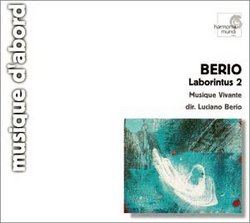| All Artists: Luciano Berio, Ensemble Musique Vivante, Christiane Legrand, Janette Baucomont Title: Luciano Berio: Laborintus 2 Members Wishing: 0 Total Copies: 0 Label: Harmonia Mundi Fr. Release Date: 11/14/2000 Album Type: Import, Original recording reissued Genres: Pop, Classical Styles: Vocal Pop, Chamber Music, Historical Periods, Classical (c.1770-1830) Number of Discs: 1 SwapaCD Credits: 1 UPC: 794881508228 |
Search - Luciano Berio, Ensemble Musique Vivante, Christiane Legrand :: Luciano Berio: Laborintus 2
 | Luciano Berio, Ensemble Musique Vivante, Christiane Legrand Luciano Berio: Laborintus 2 Genres: Pop, Classical
|
Larger Image |
CD Details |
CD ReviewsInsane, wonderful, marvellously inventive Mark Grindell | Shipley,West Yorkshire | 04/29/2003 (5 out of 5 stars) "Where else could you summon up a chorus, three sopranos, a speaker, three harps and something that sounds like a jazz orchestra?This piece specialises in some amazing vocal effects that have to do with the extension of vibration and note into time, like arrows flying through the air. There are instruments that actually finish a note that a singer STARTS, and then transforms it into a complex phrase, thus morphing and shape shifting the original utterance in a most amazing way.The piece is lots of things - a ceremony - and a sequence of chants, piercing, beautiful moments of clear sound, curious tangles of notes from the harps, and (on this recording) the patient voice of Eduardo Sanguinetti. He sounds very old, and his very distinctive voice lends a unique and strange texture to a piece that is dominated by vocal brilliance by three members of the Swingle Singers (if you didn't recognize the names).I have a copy of the score of Laborintus II, and while this performance is unmatched by any live performance I have ever seen to date, it is NOT the same exactly as the printed score.Here you can actually hear the musicians break off at the end of the first section puzzlingly speaking to each other in French, and laughing "oh..je suis tres termine!", and this is most definitely not scored.The beginning of the second piece according to the score should have the ensemble playing some extended jazz improvisations, Sanguinetti pronouncing some Dantesque poetry, the three singers and chorus doing equaly fascinating things, but the recording contains some quite different ideas, all of which work, and are ahout as insane and engaging as anything Mr Berio has ever invented. The piece seems to be something like one of the happenings that the Grateful Dead were involved in, and for all we know, perhaps everyone was so mellowed out that that is essentially what has been captured here.I've seen the piece performed twice. In both cases it was different, so in no way do I have a real handle on what the true, or platonic ideal really should be.It's also very challenging working out from the score how the various parts key together, but just listening this is a treat.I first encountered this in Hatfield in a student dive where there was some marvellous blue smoke and squashy furniture and some buffs from teh science fiction society, who thought that it was completely crazy, and we all did, and I'm happy I met it that way. Any of you guys out there, please get back in touch!" A worthy companion to "Sinfonia" A. Temple | Ann Arbor, MI | 04/20/2001 (5 out of 5 stars) "Berio's "Sinfonia" (1968) is probably his most famous piece. It's often named as his masterpiece, sometimes even as the greatest piece written after World War II. "Laborintus II" (1965) is also an amazing piece of music, though, and I think it makes an excellent companion to the later work. Both are pieces for a large group of instruments and a small group of vocalists. Both have a theatrical element. Both use the human voice in unconventional ways. Both were written in the 1960s. Both are breathtakingly beautiful, unabashedly modern, and unlike any music that came before. Despite these similarities, though, the pieces are hardly identical. While "Sinfonia" is in five movements, only one of which exceeds 10 minutes, "Laborintus II" divides its 33 minutes into only two sections. While the former is highly structured, the latter is more free-form and through-composed. While the former is very focused and much of it is static, the latter is all over the place and can be overwhelmingly propulsive. And the "Sinfonia"'s third movement, based on a Mahler scherzo and containing a huge number of quotations, finds its equivalent in "Laborintus II" with the opening of the second movement, which takes off like an avant-garde jazz piece which soon dissolves into spatterings of tape-music in one of the most effective uses of electronics I've ever heard.By the way, if you're into avant-garde rock at all, you /definitely/ owe it to yourself to get this CD. This piece is essentially the classical equivalent of Legendary Pink Dots' "So Gallantly Screaming" from _Asylum_." Berio CD is a Find lesterm277 | Sharon, MA USA | 08/16/2002 (5 out of 5 stars) "As a fan of the music of Luciano Berio, I'm always on the look-out for recordings I might have missed.I was delighted to find this one. Laborintus 2 combines many elements such as the sung word, the spoken word, progressive classical and jazzelements to form a new concept in theatrical music. The performance on this CD took me by surprise. How could I have missed itbefore? There might be one small gripe, the lack of a text and translation. But I assume that that was to keep the price down.Anyway, don't you missout on this."
|

 Track Listings (2) - Disc #1
Track Listings (2) - Disc #1